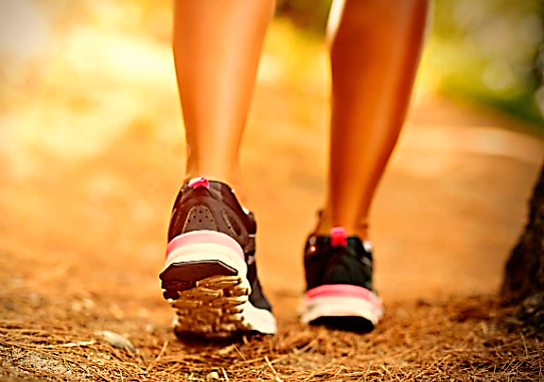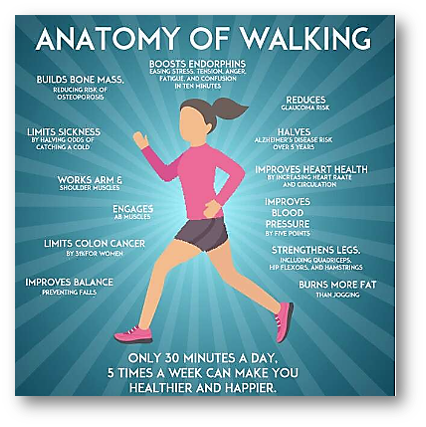
WHAT IS WALKING??
Walk is a form of physical activity that involves moving along on foot. It is the most basic form of human locomotion and is performed by people of all ages and abilities. Walking can be done for various purposes such as transportation, leisure, and exercise. When done as an exercise, it is often called “power walking” or “brisk walking” to distinguish it from leisurely strolling or casual walking.
During a walk, one foot is always in contact with the ground, and weight is transferred from one foot to the other in a smooth and coordinated manner. This repetitive motion involves the use of many muscle groups including the legs, core, and back.
Walking can be done anywhere and requires no special equipment or facilities, making it a convenient and accessible form of physical activity. It is often considered a good form of exercise for people who are new to physical activity or have been sedentary for a long period of time. It’s also beneficial for those who looking for low-impact exercise as it is easy on joints.

WALKING STYLES AND PURPOSE!!
There are several different types of walking styles and purposes, including:
Leisure walking:
This is the most common form of walking and is typically done for pleasure or as a way to explore the outdoors. Leisure walking can be done on flat or hilly terrain, on sidewalks or trails, and can be done alone or in groups.
Power walking:
Also known as brisk walking, this is a more intense form of walking that is done at a faster pace than leisure walking. It is a form of cardiovascular exercise that can be done to improve fitness and burn calories.
Race walking:
A type of athletic event that is judged by officials who determine whether the athletes are walking in compliance with the rules, which require the walker’s advancing leg to be straightened (not bent at the knee) from the moment of first contact with the ground until the vertical upward propulsion of the body.
Nordic Walking: WALK
This type of walking involves the use of specially designed poles, similar to those used in cross-country skiing, and can be done on pavement or trails. It can be done to improve fitness and burn calories but also provides a full-body workout.
Urban Hiking:
In this walking style, people walk through cities or towns instead of natural environments and urban hiking can be as much as exploring a new area, as well as getting some exercise.
Trail Walking:
This type of walking involves walking on natural trails, such as those found in parks or wilderness areas. It can be done for leisure or as a form of exercise and can be more challenging than walking on flat, paved surfaces.
Overall, the different types of walking styles and purposes vary depending on the terrain, speed, and equipment used, but all of them are aimed to improve overall health, burning calories, or explore new places.
TAKE A WALK ON THE HEALTHY SIDE!!

Walking is a form of physical exercise that has many health benefits. Some of these benefits include:
Improving cardiovascular fitness:
Walking can help increase your heart and lung fitness, which can reduce your risk of heart disease and stroke.
Strengthening muscles:
Walking can help tone your leg and core muscles, which can improve your balance and stability.
Controlling weight:
Walking can help you maintain a healthy weight by burning calories and reducing your risk of obesity.
Reducing stress:
Walking can be a great way to reduce stress and tension, as it can help clear your mind and improve your mood.
Improving mental health:
Regular walking has been shown to improve symptoms of depression and anxiety and may have a positive impact on cognitive function
Boosting bone density:
By bearing weight during walking it can help to strengthen bones and reduce the risk of osteoporosis.
Low-impact exercise:
Walking is a low-impact exercise, which means it is easy on your joints and can be done by people of all ages and fitness levels.
Overall, walking is a simple and effective way to improve your physical and mental health, and it can be easily integrated into your daily routine.
FIND YOUR PATH TO WELLNESS THROUGH WALKING!!
Walking is a form of physical activity that can be beneficial for people with a variety of health conditions. Here are some recommendations for walking with different diseases:
Cardiovascular disease:
Walking is a great form of exercise for people with heart disease. It can help improve cardiovascular fitness, lower blood pressure and reduce the risk of heart attack and stroke.
Diabetes:
Walking can help control blood sugar levels in people with diabetes. It also helps to lower the risk of developing complications from diabetes such as nerve and kidney damage.
Osteoarthritis:
Walking is a low-impact exercise that can be done by people with arthritis. It can help improve joint mobility, strength, and flexibility, and can reduce pain and inflammation.
Obesity:
Walking is a great way to burn calories and lose weight. It can help improve body composition and overall fitness.
Depression and anxiety:
Walking can help reduce symptoms of depression and anxiety and can also improve mood.
COPD:
Walking can help improve lung function and increase endurance in people with chronic obstructive pulmonary disease (COPD).
It’s important to consult with a physician before starting any exercise program, especially in case of chronic illness. They can provide guidance on the appropriate type, duration, and intensity of exercise, as well as any precautions or modifications that may be necessary.
WALKING TIME AND DURATION!!

The best way to walk, in terms of time and duration, varies depending on the individual and their specific health goals. However, the general recommendation for moderate-intensity exercises, such as brisk walking, is at least 150 minutes per week for adults. This can be broken down into shorter sessions of 30 minutes or more, such as five 30-minute walks per week.
It is also recommended that adults should perform muscle-strengthening exercises at least twice a week, so 10-15 min of resistance training could be added to the walking routine.
For people with chronic health conditions or for those who are new to exercise, it may be best to start with shorter duration and lower intensity and gradually increase the time and intensity of walking as fitness improves. It’s also important to listen to your body and not push yourself too hard.
It’s always best to check with your doctor or healthcare provider before starting an exercise program, especially if you have any underlying health condition. They can help determine the appropriate time and duration of exercise for your individual needs and fitness level.
WALKING FOR WEIGHT LOSS!! WALK
Walking is an effective way to lose weight and can be a part of a comprehensive weight-loss plan. Here are some recommendations for using walking to lose weight,
as suggested by doctors:
- Aim for at least 30 minutes of moderate-intensity walking, most days of the week. This can be done in one continuous 30-minute session or in shorter 10-minute sessions throughout the day.
- Increase the intensity of your walks. Brisk walking, or power walking, burns more calories than leisurely walking. You can increase the intensity by walking faster, inclining the terrain, or carrying weights.
- Combine walking with strength training exercises. Building muscle can help increase your metabolism, which can help you burn more calories even when you’re not exercising.
- Add variety to your walking routine. Walking on different terrains, using Nordic poles, or doing interval training can make your walks more challenging and interesting.
- Track your progress. Keeping a record of how far you walk, how many calories you burn, and how your clothes fit can help you stay motivated and on track.
- Eat a balanced and healthy diet. Walking can help you burn calories, but it’s also important to pay attention to the number of calories you’re taking in. Eating a diet that’s rich in fruits, vegetables, lean proteins, and whole grains can help support your weight loss goals.
Get Back To Nature and Get in Shape”
It is important to note that weight loss is complex and can be influenced by many factors, including genetics, metabolism, and overall lifestyle. Therefore, combining walking with a healthy diet and other lifestyle changes is the most effective way to achieve weight loss and maintain weight loss over the long term. It’s also important to talk to your doctor or healthcare provider before starting any weight loss program, especially if you have any underlying health conditions. They can provide guidance on the appropriate type, duration, and intensity of exercise, as well as any precautions or modifications that may be necessary.
WALKING IN CLINICAL ASPECTS!!
Walking is a form of physical activity that can have a number of clinical benefits. Here are a few ways that walking can impact the body and improve health:
Cardiovascular health:
Walking can help improve cardiovascular fitness by increasing heart and lung function. It can lower blood pressure, decrease the risk of heart disease and stroke, and improve circulation throughout the body.
Metabolic health: walk
Walking can help control blood sugar levels and improve insulin sensitivity, making it beneficial for people with diabetes. It can also aid in weight management and obesity by burning calories and reducing body fat.
Muscular and skeletal health:
Walking can help improve muscular strength, endurance, and tone. It also helps in bone density and can reduce the risk of osteoporosis.
Mental health:
Walking has a positive impact on mental health. It is helpful in reducing symptoms of depression and anxiety. It can also improve cognitive function and reduce stress.
Cell and molecular level action:
Walking can help reduce inflammation in the body, which can in turn help reduce the risk of chronic disease. Additionally, walking triggers the release of growth factors, enzymes, and other molecules that can promote the growth of new blood vessels and nerves, helping the body to repair itself.
Physiological benefits:
Furthermore, regular walking has the potential to enhance several key aspects of overall health. Specifically, it can elevate the activity of enzymes responsible for fat breakdown, increase insulin efficiency and reduce LDL cholesterol levels. Additionally, walking has been known to improve lung function and strengthen the immune system. It’s worth mentioning that the simplicity and accessibility of walking make it an ideal form of exercise. It can easily be incorporated into one’s daily routine, can be practiced by people of all ages and fitness levels, and requires no special equipment or facilities
KEYWORDS: footpath, pedestrian, exercise, leisure, transportation, gait, stride, step, and ambulatory.
REFERENCES:
http://runels.com/LawofHealth/3Climb/Walking,%20by%20Henry%20David%20Thoreau.pdf


Pingback: HEALTH BENEFITS OF GREEN TEA!! - Life Biologs